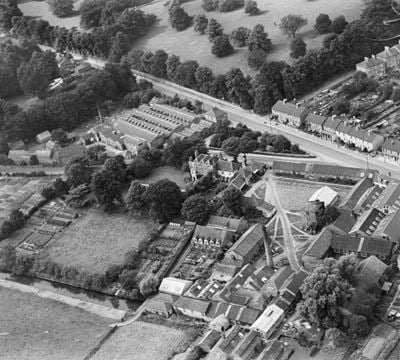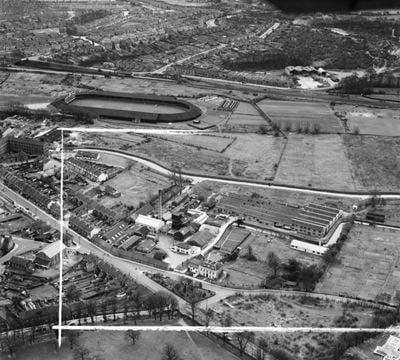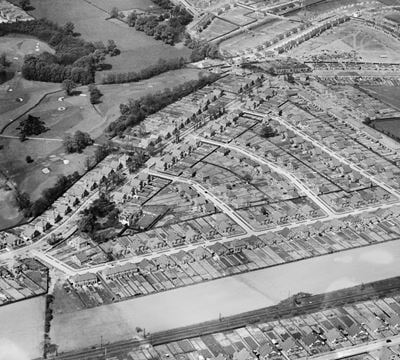Historic Bexley
Explore hidden histories, historic photos, and things you never knew about Bexley from the collections and archives of Historic England.
Discover Bexley's listed buildings and places
Introducing some of Bexley's most significant historic sites, curated from the National Heritage List for England. Skip this section and go to place by numbers
World War Ii Heavy Anti-Aircraft (Haa) Battery
Bexley
Slade's Green Heavy Anti-aircraft battery, of late 1930s date, is designated at Grade II for the following principal reasons: *
Faesten Dic, a medieval frontier work in Joydens Wood
Wilmington
A small number of substantial and defensible boundary features have been identified as frontier works marking territories in the early medieval period.
Crossness Pumping Station
Bexley
Crossness Pumping Station, opened on April 4, 1865, engineered by Joseph Bazalgette, features notable cast iron architecture and beam engines by James Watt and Co., highlighted in a 1969...
Lesnes Abbey
Bexley
From the time of St Augustine's mission to re-establish Christianity in AD 597 to the reign of Henry VIII, monasticism formed an important facet of both religious and secular life in the...
Hall Place
Bexley
Country houses of the late Tudor and early Jacobean period comprise a distinctive group of buildings which differ in form, function, design and architectural style from country houses of...
First World War Memorial at St John the Baptist Church, E…
Bexley
First World War memorial. Erected 1921. Read the official list entry to find out more.
Lamorbey Park
Bexley
Early C20 gardens and early C19 pleasure grounds set in a park dating from the mid-C18. Read the official list entry to find out more.
Crayford War Memorial in grounds of Crayford Manor
Bexley
War memorial, unveiled in 1954. Read the official list entry to find out more.
Red House
Bexley
Red House in Bexleyheath, built in 1859 by Philip Webb for William Morris, features a picturesque Gothic design.
Danson Park Mansion
Bexley
Danson Park Mansion, built in 1765 by Sir Robert Taylor for Alderman John Boyd, features Portland stone, a central oval staircase, and grounds designed by 'Capability' Brown.
Erith (Christ Church) War Memorial
Bexley
First World War memorial in the form of a marble cross on a plinth. Read the official list entry to find out more.
North Cray War Memorial
Bexley
War memorial in the form a stone Celtic cross on a plinth, unveiled 1920. Read the official list entry to find out more.
Garden Wall, Gatepiers and Gates to North Amd West of Hal…
Bexley
The Garden Wall, Gatepiers, and Gates to the north and west of Hall Place date back to the 18th century. They feature red brick walls, stone baluster-finials, and wrought iron railings.
Explore more
See more listed placesHistoric Bexley through time
The National Heritage List for England contains hundreds of details about buildings and places, including the periods in which they were built and the uses they've had over the years. Explore how your local area has changed through time. Skip this section and go to aerial photos
Early medieval AD 410 to AD 1066
This period, often associated in England with Anglo-Saxons and Vikings, saw a reduction in urban living from the Roman period and increased migration from northern Europe.
Traces of this period can be found in cemeteries, particularly in artefacts and in some of the very early churches, as this period also saw the growth of Christianity in Britain.
Medieval AD 1066 to AD 1540
This period, sometimes known as the Middle Ages, began with the Norman invasion in AD 1066. It saw a significant rise in military and defensive buildings such as castles and earthworks, as well as religious houses dominating a largely agricultural landscape.
The monarchy and Church dominated the period, which also saw the break with the Roman Church and the English reformation.
Post medieval AD 1540 to AD 1901
The Post-Medieval period brought seismic changes to life in England, with religious reformation leading to the democratization of worship and the destruction of hundreds of religious houses.
In parallel, there was a huge expansion of scientific study and enlightenment that permanantly altered the nation's social structure and landscape. Industrialization and mass production lead to wider global trade, emigration, and immigration.
20th century AD 1901 to AD 2000
The 20th century saw an incredible expansion of England's transport networks, with suburban growth shadowing rapid infrastructural expansion. The establishment of state schools, hospitals, and modern technical colleges, with new architectural styles, radically changed the appearance of towns and cities.
Two catastrophic world wars and the 1918 pandemic also brought unprecedented change, altering England's built environment and social structures forever.
Early medieval AD 410 to AD 1066
This period, often associated in England with Anglo-Saxons and Vikings, saw a reduction in urban living from the Roman period and increased migration from northern Europe.
Traces of this period can be found in cemeteries, particularly in artefacts and in some of the very early churches, as this period also saw the growth of Christianity in Britain.
Medieval AD 1066 to AD 1540
This period, sometimes known as the Middle Ages, began with the Norman invasion in AD 1066. It saw a significant rise in military and defensive buildings such as castles and earthworks, as well as religious houses dominating a largely agricultural landscape.
The monarchy and Church dominated the period, which also saw the break with the Roman Church and the English reformation.
Post medieval AD 1540 to AD 1901
The Post-Medieval period brought seismic changes to life in England, with religious reformation leading to the democratization of worship and the destruction of hundreds of religious houses.
In parallel, there was a huge expansion of scientific study and enlightenment that permanantly altered the nation's social structure and landscape. Industrialization and mass production lead to wider global trade, emigration, and immigration.
20th century AD 1901 to AD 2000
The 20th century saw an incredible expansion of England's transport networks, with suburban growth shadowing rapid infrastructural expansion. The establishment of state schools, hospitals, and modern technical colleges, with new architectural styles, radically changed the appearance of towns and cities.
Two catastrophic world wars and the 1918 pandemic also brought unprecedented change, altering England's built environment and social structures forever.
Aerial photos of Bexley
Historic aerial photography shows the growth and changes in England's urban and rural landscapes, revealing secrets that are impossible to see from the ground. Skip this section and go to archive images

Crayford
Dover Road Silk and Calico Print Works, Crayford, 1929

Crayford
The David Evans & Co Ltd Silk Printing Works and environs, Crayford, 1953

Sidcup
The Montrose Park Estate between Hurst Road and Faraday Lane, Sidcup, 1934

Sidcup
The Montrose Park Estate between Hurst Road and Canterbury Avenue, Sidcup, 1934

Bexley Woods
Hurst Road and environs, Bexley Woods, 1934

Bexley Woods
Hurst Road, the SR Dartford Loop and environs, Bexley Woods, 1934

Bexley
New housing site near Blackfen and Lamorbey Park Golf Course, Bexley, 1932

Bexley Woods
The Albany Park Estate under construction to the north of Hurst Road, Bexley Woods, 1934

Sidcup
Greenwich Cottage Homes and new housing around Marlborough Park and environs, Sidcup, 1932

Sidcup
The Marlborough Park Estate, Sidcup, 1934
Historic England Archive images of Bexley
The Historic England Archive holds and cares for over 15 million images, from the 1850s to the present day. Discover stunning images of Bexley's past. Skip this section and go to stories about heritage
Charles George Harper Collection
Erith, Bexley, Greater London Authority
Date created: 1892 - 1933
A boat at a wharf on the River Thames at Erith
John Gay Collection: Modern Architects
Northumberland Heath, Bexley, Greater London Authority
Date created: 1970 - 1980
The Lambert Court flats in Erith seen from Randall Close
Nigel Temple Collection of Postcards of Parks and Gardens
Bexley, Greater London Authority
Date created: 1911 - 1916
EXTERIOR VIEW SHOWING ENTRANCE AND PART OF GATE LODGE
Charles George Harper Collection
Purfleet, Dartford, Kent
Date created: 1892 - 1933
Looking across the mouth of the River Darent at Purfleet, showing a sailing ship at anchor
John Gay Collection: Modern Architects
Northumberland Heath, Bexley, Greater London Authority
Date created: 1970 - 1980
The houses of Randall Close, Erith with Lambert Court flats in the background
Nigel Temple Collection of Postcards of Parks and Gardens
Danson Park, Bexley, Greater London Authority
Date created: 1920 - 1940
General view along the Long Walk in Danson Park
John Gay Collection: Modern Architects
Northumberland Heath, Bexley, Greater London Authority
Date created: 1970 - 1980
The east end of Randall Close, Erith
John Gay Collection: Modern Architects
Northumberland Heath, Bexley, Greater London Authority
Date created: 1970 - 1980
The houses of Randall Close, Erith with Lambert Court flats in the background
John Gay Collection: Modern Architects
Northumberland Heath, Bexley, Greater London Authority
Date created: 1970 - 1980
A view looking towards the entrance of the Lambert Court flats in Erith
John Gay Collection: Modern Architects
Northumberland Heath, Bexley, Greater London Authority
Date created: 1970 - 1980
The modern flats and garden at Lambert Court in Erith seen from Park Crescent
John Gay Collection: Modern Architects
Northumberland Heath, Bexley, Greater London Authority
Date created: 1970 - 1980
The modern flats at Lambert Court in Erith
John Gay Collection: Modern Architects
Northumberland Heath, Bexley, Greater London Authority
Date created: 1970 - 1980
The complex of modern flats at Lambert Court in Erith
Stories about heritage in Bexley
Historic England publishes news, blogs, videos and podcasts celebrating England's heritage. Discover the stories we have about Bexley. Skip this section and go to education
The Story of London’s Sewer System
Mentions Crossness Pumping Station
Hidden beneath London’s streets lie incredible tunnels and sewers that take waste from our homes.
Explore your social history through photos
Over 10,000 images from the Historic England Archive have been specially selected and re-captioned for teachers, students, and anyone who wants to learn more about heritage in their local area. Skip this section and go to grant-aided places
Tudor Cottages, Foots Cray High Street, Sidcup, Greater London
Period: Tudor (1485 - 1602)
This timber framed building dates back to the late 15th or early 16th century. It was originally a Wealden house.
Tudor Cottages, Foots Cray High Street, Sidcup, Greater London
Tags
Styleman's Almshouses, High Street, Bexley, Greater London
Period: Georgian (1714 - 1836)
These 12 almshouses were built in 1755.
Styleman's Almshouses, High Street, Bexley, Greater London
Post on the East side of Maiden Lane, Dartford, Kent
Period: Victorian (1837 - 1901)
This post lies just south of railway enbankment and north of Cranford House and is dated 1864. It was put up by the Regents Canal Co.
Post on the East side of Maiden Lane, Dartford, Kent
Foster's Primary School, Upper Wickham Lane, Bexley, Greater London
Period: Victorian (1837 - 1901)
This school and schoolmaster's house were built in 1879 for Foster's Educational Trust.
Foster's Primary School, Upper Wickham Lane, Bexley, Greater London
Former Workhouse, Bexley High Street, Bexley, Greater London
Period: Georgian (1714 - 1836)
This building dates back to 1787. It was originally built as a parish workhouse.
Former Workhouse, Bexley High Street, Bexley, Greater London
Former Bexley National Schools, Bourne Road, Bexley, Greater London
Period: Georgian (1714 - 1836)
This school is dated 1834 and has the inscription 'Bexley National Schools' on it.
Former Bexley National Schools, Bourne Road, Bexley, Greater London
Erith Library, Walnut Tree Road, Erith, Greater London
Period: Edwardian (1902 - 1913)
This Public Library was built in 1906 by W Egerton. It was built with money from the Andrew Carnegie Fund.
Erith Library, Walnut Tree Road, Erith, Greater London
Crossness Pumping Station, Bexley, Greater London
Period: Victorian (1837 - 1901)
A large group of men, many in top hats, posed in front of Crossness Pumping Station, Bexley, which is surrounded in wooden scaffolding, and which was...
Crossness Pumping Station, Bexley, Greater London
Visit grant-aided places near you
These places and buildings have been helped by Historic England's financial grants. Find local heritage in your neighbourhood that you never knew existed! Please note that opening times may vary. Skip this section and go to related locations
Crossness Beam Engine House, Old Works - Thames Water STW
A Grade I listed beam engine house that opened in 1865, designed by engineer Joseph Bazalgette in the Romanesque style.


